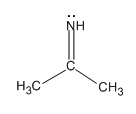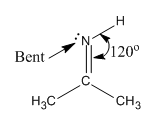
Concept explainers
Interpretation:
Molecular geometry and electron geometry about nitrogen atom in the acetone imine molecule is to be predicted.
Concept introduction:
Electron geometry and molecular geometry of molecules is determined by using Valence shell electron pair repulsion (VSEPR) theory. According to VSEPR theory, electron geometry describes the orientation of the electron groups about a particular atom, and molecular geometry describes the arrangement of atoms about a particular atom.
Number of electron pairs describes the electron and molecular geometry. If all the electron pairs are bonds, then molecular geometry is the same as electron geometry. Electron geometry is different from molecular geometry if some electron pairs are present as lone pairs.
Electron geometry and molecular geometry from the number of electron pairs are as follows:
| Number of electron pairs |
Number of Bonds |
Number of Lone pair |
Electron geometry | Molecular Geometry |
| 2 | 2 | 0 | Linear | Linear |
| 3 | 3 | 0 | Trigonal planar | Trigonal planer |
| 3 | 2 | 1 | Trigonal planar | Bent |
Answer to Problem 2.1P
Electron geometry about N atom in acetone imine molecule geometry is trigonal planar and molecular geometry is bent.
Explanation of Solution
The given acetone imine molecule is

In acetone imine molecule, there are total three groups of electrons about N atom. There is one double bond, one single bond, and one lone pair around N atom, that is, all electron pairs are not involved in bond formation, and hence, molecular geometry and electron geometry are different.
There are total three electron groups, hence, the electron geometry about N atom is trigonal planar. The molecular geometry is bent.

Electron geometry and molecular geometry about N atom is predicted from the number of electron pairs present around the atom in the given molecule.
Want to see more full solutions like this?
Chapter 2 Solutions
ORGANIC CHEMISTRY PRINCIPLES & MECHANISM
- Answer this question: Based on the results of the solubility tests and chemical tests, what is the most probable structure of C6H5C3H5O? Draw your answer in the box You may draw the compound usingline-bond formula OR Lewis structure. Problem statement:You were tasked to propose a structure for a compound with a chemical formula of C6H5C3H5O. In the laboratory, the compound appears as a clear, colorless liquid. See table 1, for the results of solubility tests for C6H5C3H5O. Table 1. Results of the solubility tests for C6H5C3H5O. SOLUBILITY TEST OBSERVATIONS +(soluble/miscible)/ - (insoluble) distilled water two layers of liquid - 10% NaHCO3 two layers of liquid - 10% NaOH two layers of liquid - 10% HCl two layers of liquid - concentrated H2SO4 pinkish solution + Based on the results of the solubility tests, the compound can be grouped in VI, which is insoluble in water, 10% NaOH and 10% HCl but soluble in concentrated H2SO4. If the…arrow_forwardAnswer the following true or false questions about the molecule acrylaldehyde, its resonance structures, and resonance hybrid. In fairness, many of these statements are false and represent common misconceptions about resonance. If a statement is false as written, change the underlined fragment of the statement to make it true 4) The pair of electrons labeled “A” (at the end of the arrow) are localized 5) The pair of electrons labeled “B” (at the end of the arrow) are delocalized 6) The pair of electrons labeled “C” (at the end of the arrow) are localizedarrow_forwardWould each end of the bond line structure be carbon? Is problem (a) correct?arrow_forward
- In a tabular format, compare (or contrast) the main feature, strengths and limitations of the following molecular visualizations that can be generated in MolView. 1) ball and stick model 2) van der Waals spheres 3) skeletal structure 4) MEP model Using a maximum of five sentences, explain why molecular visualizations are important in studying macroscopic phenomena.arrow_forwardParaphrasing .ewriting Tool Car note Pirate Ship BLACKBOARD [Review Topics] [References] Carbon-hydrogen bonds exhibit a range of different chemical reactivity that depends on molecular structure. Classify the C-H bonds at the carbons labeled a-c in the structure below. Possible classifications are: primary, secondary, & tertiary or none if there are no hydrogens at the labeled carbon. C-H bond(s) at a( C-H bond(s) at b C-H bond(s) at c Submit Answer Retry Entire Group 9 more group attempts remaining (Previous Next Save and Exit O 14 étv MacBook Air DII 30 888 F11 F12 FB F9 F10 F7 F5 * & 4 5 6 8. de Y 11 F G V B M + ||arrow_forwardPlease correct answer and don't use hend raitingarrow_forward
- Draw the curved arrows to show the resonance structure for the following molecules. ( there are 3 molecules )arrow_forwardDraw out Lewis Dot structure for acetic acid (show step by step procedure), indicate hybridization of carbons.arrow_forwardClick on all of the atoms that make up the largest coplanar unit in the molecule below. XX H H -Harrow_forward
- Please correct answer and don't use hend raitingarrow_forwardSelect if the following statements are true or false. Group of answer choices In VB theory, all the electrons in the structure are delocalized. The number of hybridized orbitals always equals the number of atomic orbitals on the central atom. VB theory accurately predicts bond strength, angle and length. According to VB theory, the more overlap of orbitals, the longer the bond length.arrow_forward3 Consider this compound when answering the questions below. OH How many units of unsaturation does this compound have? type your answer... How many atoms are sp² hybridized? type your answer... How many bent atoms are there? type your answer... Previousarrow_forward
 Organic Chemistry: A Guided InquiryChemistryISBN:9780618974122Author:Andrei StraumanisPublisher:Cengage Learning
Organic Chemistry: A Guided InquiryChemistryISBN:9780618974122Author:Andrei StraumanisPublisher:Cengage Learning
 Chemistry for Today: General, Organic, and Bioche...ChemistryISBN:9781305960060Author:Spencer L. Seager, Michael R. Slabaugh, Maren S. HansenPublisher:Cengage Learning
Chemistry for Today: General, Organic, and Bioche...ChemistryISBN:9781305960060Author:Spencer L. Seager, Michael R. Slabaugh, Maren S. HansenPublisher:Cengage Learning



